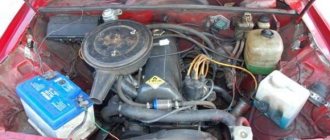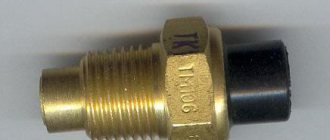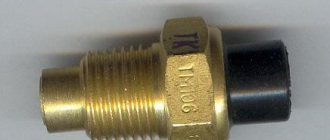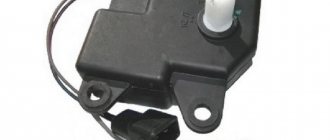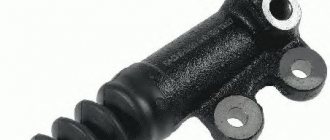The viscous coupling of a car fan is exactly the part that many car enthusiasts know firsthand, but know practically nothing about the features of its design. But this is a very interesting device in its simplicity, which does not break down very often - it is so reliable. However, a competent car enthusiast should know about the features of the design and operation of both large and small car components so that if they break down, he can quickly figure out whether a trip to the service station is necessary literally on the same day, or whether repairs can be postponed. Now we will try to figure out how the viscous coupling of a cooling fan works, what is the principle of its operation, and even how to repair it.
Details about the operating principle
The viscous coupling (viscous coupling) of the fan is a mechanism that regulates the rotation speed of the fan. Consists of a housing and two rows of disks that do not have a rigid connection. The energy of rotational motion is transferred from the drive shaft to the driven shaft due to the rotation of the fluid, which changes viscosity as the operating temperature of the engine changes.
In fact, viscous couplings have found application not only in the automotive industry, but even in wind energy, which focuses on rather large installations. And the peculiarity of this coupling is that it allows selective transmission of torque. Viscous couplings can be arranged according to 2 schemes:
- Sealed housing with two or more turbine wheels equipped with an impeller. One wheel is on the drive shaft, and the second is on the driven shaft. The space around them is filled with a viscous silicone-based liquid. If the turbine wheels rotate at different speeds, the liquid will ensure the transmission of torque to the driven wheel and synchronize their rotation;
- A similar body with a pair of flat discs with protrusions and holes, the same silicone liquid. If the rotation of the disks is synchronous, the liquid practically does not mix. If the driven disc lags behind the master, the mixing becomes enormous. Initially, the unconnected discs are pressed against each other due to the rapid expansion of the silicone liquid. It is this kind of disk system that is used in viscous coupling cooling fans.
Here it is worth telling more about the so-called. silicone-based dilatant liquid, which fills the sealed viscous coupling body. This liquid is really viscous under normal conditions, but it remains fluid. But as soon as you start stirring or heating it, it thickens and begins to occupy a slightly larger volume. At the same time, the density will also change - the dilatant liquid will become similar to stuck glue. In the absence of thermal or mechanical influences, it will return to its normal liquid state . Here we cannot help but talk about another interesting point: when the liquid is strongly mixed, it becomes so viscous that the viscous coupling is blocked.
About the liquid inside
At the very beginning, I would like to talk about the liquid that is inside the viscous coupling, what it is and what properties it has.
To begin with, I would like to say that what is poured inside is a dilatant liquid, which is based on silicone. Its properties are very interesting: unless it is heated or stirred too much, it remains liquid. BUT if you mix it strongly and heat it a little, it thickens and expands very much, becoming more like frozen glue. After mixing again becomes insignificant, it again acquires its original state of aggregation, that is, it becomes liquid.
It is worth noting that the liquid is filled for the entire service life of this unit and cannot be replaced.
A little about the use of viscous couplings
Today, viscous couplings in the automotive industry are used in only two cases, and the first one is still relevant, but it is also being gradually abandoned. So:
- For cooling the internal combustion engine . The very viscous fan couplings that this material is devoted to can be called a vanishing technical solution. Everything is arranged extremely simply: a coupling with a fan driven through a belt drive is attached to the rod. The system itself performs well in winter, but in summer the viscous fan couplings perform not so well. They are being replaced by electronic fans working in tandem with a special sensor;
- To connect all-wheel drive . As practice shows, today in 70 or even 80 percent of crossovers, viscous couplings are installed, which are responsible for connecting all-wheel drive in automatic mode. But they are also gradually being replaced by electromechanical devices.
Spare parts for Hafei princip
Front engine camshaft oil seal
PRINCIP/SAIBAO sedan (05 — )
Spare parts for Audi 80
Shock absorber for trunk lid (3/5th rear door) 80 sedan (89, 89Q, 8A, B3) (06.86 - 10.91)
Why do viscous couplings remain relevant in general? There are several reasons:
- They are simple and very reliable;
- Viscous couplings are quite cheap. More complex electromechanics are more expensive for automotive component manufacturers;
- They are very durable. The device body can easily withstand pressure from 15 to 20 atmospheres . There are often cases when a car with a viscous coupling is sold after 7 years of operation and its new owner does not face the problem of device failure for many years to come.
However, there are also disadvantages. For example, viscous couplings are not very repairable. The descriptions for these devices say almost in plain text that they are disposable and, in general, their repair is impractical. In addition, such devices are not designed for long-term operation, although practice shows that they can work for a very long time - a pleasant exception to the rule. If viscous couplings are used in the drive, the system turns out to be not very effective - the maximum torque is transmitted only when the front wheels slip strongly, connecting the drive manually becomes impossible, etc.
Advantages and disadvantages
Among the advantages of VM it should be noted:
- Simplicity of design. Indeed, the unit is automatically put into operation without the use of any special sensors (measuring wheel speed) or an electronic control unit.
- Low cost.
- Durability. If you follow the operating rules recommended by the manufacturer, the service life of the viscous coupling is designed for the entire “life” of the car.
- No need for periodic maintenance.
- High hull strength. Its design can withstand pressure of even 15÷20 atm (the increase occurs due to heating and expansion of the liquid).
Functionality check
Viscous couplings of radiators are not so difficult to check. The operating manuals indicate that fan rotation should be checked first on a cold and then on a hot engine. At the same time, on a hot engine, when the engine is revved up, the rotation speed seriously increases, while on a cold engine it does not. The “folk” method of checking is very good, since it also involves caring for the engine cooling system. Here's what to do:
- Without starting the engine, try to rotate the fan blades with your hand or an improvised object. They should spin with little resistance, but without inertia;
- Start the engine and listen. In the first seconds, the motorist should hear a slight noise, which will gradually subside;
- After warming up the engine slightly, try to stop the blades with a folded sheet of paper. They must stop, but with a clearly noticeable effort;
- Remove the viscous coupling and warm it up strongly. Optionally, in boiling water. After this, the clutch should resist rotation. If it turns, there is practically no silicone liquid left inside. It is also recommended to remove the engine cooling radiator and wash it;
- Check the longitudinal play of the device. If there is one, the coupling must be repaired.
Please note that if one of the verification stages has not been passed, there is no point in going further along the list. However, it always makes sense clean the radiator
How repairs are made
The first thing a car enthusiast should pay attention to is engine overheating. Perhaps it is the viscous coupling that is connected to it, although it is worth checking, for example, the thermostat. If the problem lies specifically in the viscous coupling, it is worth trying to repair it. Although many descriptions say that replacing silicone liquid is impossible and it is poured into the case once until the entire device is disposed of, in practice, adding fresh liquid is very simple. The only problem is to find it. In both offline and online stores it can be found under the names “ viscous coupling repair fluid ”, “ viscous coupling oil ” or simply “ silicone fluid ”. If we are talking about repairing a viscous coupling in an all-wheel drive system, then you should buy the original one - inexpensive analogues are not viscous enough. And if you are repairing a viscous fan coupling, you can buy a universal fluid.
So, to repair a broken part, you should start by checking the silicone fluid level . It leaks very often. It is necessary to fill in new fluid, for which the following is done:
- The viscous coupling is dismantled and disassembled;
- The coupling is laid horizontally, after which the pin located under the plate with the spring is removed from it. If there is no hole for the drain, you will have to do it yourself, which experienced repairmen do not recommend doing;
- After removing the pin, about 15 ml of silicone liquid is poured in with a regular syringe. The liquid is poured in gradually, pausing for half a minute or a minute so that the silicone can disperse between the discs;
- The viscous coupling is wiped, assembled and installed in place.
Noise during operation of the viscous coupling indicates failure of the bearing with which it is equipped. To replace the bearing, you need to actually do the same as described above, and also perform a few more operations. For this reason, we immediately note that when replacing a viscous coupling bearing, the old silicone fluid must be drained, and immediately after replacing the part, a new portion of silicone must be poured. And here's what to do with a broken bearing:
- Remove the viscous coupling;
- After draining the liquid, remove the upper disk and dismantle the bearing using a specialized tool (puller). You will also need to grind down the flare. We strongly do not recommend removing it with improvised means. Afterwards, install a new bearing. A sealed bearing with no visible balls will do. As described above, fresh liquid is poured in;
- The device is returned to its place.
It is important to take into account here that the viscous coupling does not tolerate force impacts - even if you slightly deform the disk, you will make further repairs impossible The device itself is coated with a thin layer of special lubricant, which is best not removed during repairs. In all other respects, the procedure cannot be called very complicated. Practice shows that many car enthusiasts who undertake independent repairs of a viscous fan coupling encounter some difficulties with reassembling the device. We advise you to either find video tutorials or record each stage of work on your smartphone camera.
Using viscous couplings in practice
This mechanism is mainly used on all-wheel drive vehicles with increased cross-country ability as a self-locking differential between axles; it is not used as an independent axle differential.
Occasionally, a viscous coupling is used as an automatic locking mechanism for a traditional differential with gears: the Thema and Dedra 2000 Turbo models of the Italian Lancia. In order to synchronize the torque of two axles, front and rear, there is simply no simpler and cheaper way than using a viscous coupling. Due to the relatively small difference in torques that arise on both axles of the vehicle under standard road conditions, the accuracy of the clutch is quite sufficient.
The operation of the viscous clutch successfully prevents the effect of slipping of the wheels of the front axle relative to the wheels of the rear axle. This is especially often possible when the vehicle is driving over very rough terrain.
If we talk about modern solutions, automakers are using viscous couplings less and less, giving preference to the more advanced forced-controlled Haldex couplings. They cool significantly better and interact with ABS systems. Therefore, knowing what a viscous coupling is, you should not rely on it completely. Time passes and there is a replacement for everything.
Selecting a new device
Now let's answer the question of how to choose a viscous coupling for a cooling fan. The easiest way to search is in online stores, because here you can, if not buy a new device, then at least find out the code of the original and the codes of all possible analogues. We'll talk about the latter shortly. You can search by:
- VIN code;
- Vehicle data. We are talking about the make, model, year of manufacture and engine parameters. Typically, this search method is the main one in online auto parts stores.
Of course, an important search parameter is the manufacturer of the final product. Many car enthusiasts justifiably do not trust the products of packaging companies. In the case of viscous couplings, you can even take products from such companies, since, in fact, they are produced by a limited number of companies, which are also suppliers to the conveyors of large automobile concerns and whose products are even sold by packers . It is worth paying attention to the products of these companies:
- Behr-Hella (Germany);
- Nissens (Denmark);
- Mobis (South Korea);
- Beru (Germany).
Very good solutions can be found in the catalogs ] Meyle[/anchor] and Febi (Germany). The Polish and Turkish analogs that appeared relatively recently did not perform so well. As a rule, reputable manufacturers of viscous couplings simultaneously produce radiators, fasteners and some pipeline elements. If you are confident in a certain radiator manufacturer, it is worth looking in its catalogs for the viscous coupling you need.
Conclusion
The viscous coupling of an engine cooling fan is a simple and very reliable device that rarely fails. You can diagnose its breakdown without contacting specialists at a service station. One has only to monitor the engine temperature and check the operation of the fan, and everything will become clear. Although viscous coupling repair is not recommended by many experts, even a beginner can handle it. The choice of new devices is quite large: there are products from manufacturing companies from Europe, America and individual Asian countries (the best options), and there are auto parts from packaging companies, the best of which are German, American and French.
Is it possible to repair a cooling fan?
The coupling lasts a very long time, there is nothing much to break or wear out there. After the end of its service life, it is replaced with a new one, since the reliability of the cooling system must always be at its best; the consequences are too expensive. But craftsmen are trying to repair viscous couplings by replacing the liquid in them.
The procedure is quite simple, you just need to carefully drill holes in the housing to change the oil and prepare reliable plugs for them.
The difficulties lie elsewhere - it is very difficult to accurately select a liquid of the required viscosity and determine its exact quantity. Otherwise, the clutch will not work normally, but there is already experience on the Internet, if you wish, it is easy to familiarize yourself with it, remembering that all clutches are different, the data for a specific model of car and engine is important.

